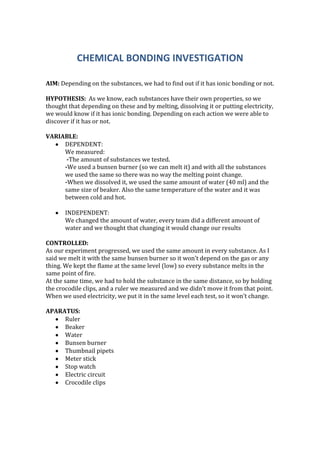Chemical bonding investigation
•
0 likes•490 views
chemical bonding
Report
Share
Report
Share

Recommended
Recommended
More Related Content
What's hot
What's hot (20)
Investigating whether the temperature change during the rate

Investigating whether the temperature change during the rate
Investigating whether the temperature change during the rate

Investigating whether the temperature change during the rate
Similar to Chemical bonding investigation
Done by Flash of Talents group at Al-Shaymaa school. Under supervision from AL-Bairaq
Manipulation of Light In the Nanoworld, The Healthy Stairs IDM13

Manipulation of Light In the Nanoworld, The Healthy Stairs IDM13Qatar University- Young Scientists Center (Al-Bairaq)
Similar to Chemical bonding investigation (20)
Manipulation of Light In the Nanoworld, The Healthy Stairs IDM13

Manipulation of Light In the Nanoworld, The Healthy Stairs IDM13
The scientific method and experimental design 9th grade biology

The scientific method and experimental design 9th grade biology
Recently uploaded
This presentation was provided by William Mattingly of the Smithsonian Institution, during the fourth segment of the NISO training series "AI & Prompt Design." Session Four: Structured Data and Assistants, was held on April 25, 2024.Mattingly "AI & Prompt Design: Structured Data, Assistants, & RAG"

Mattingly "AI & Prompt Design: Structured Data, Assistants, & RAG"National Information Standards Organization (NISO)
Recently uploaded (20)
IGNOU MSCCFT and PGDCFT Exam Question Pattern: MCFT003 Counselling and Family...

IGNOU MSCCFT and PGDCFT Exam Question Pattern: MCFT003 Counselling and Family...
BAG TECHNIQUE Bag technique-a tool making use of public health bag through wh...

BAG TECHNIQUE Bag technique-a tool making use of public health bag through wh...
9548086042 for call girls in Indira Nagar with room service

9548086042 for call girls in Indira Nagar with room service
Kisan Call Centre - To harness potential of ICT in Agriculture by answer farm...

Kisan Call Centre - To harness potential of ICT in Agriculture by answer farm...
Z Score,T Score, Percential Rank and Box Plot Graph

Z Score,T Score, Percential Rank and Box Plot Graph
Ecosystem Interactions Class Discussion Presentation in Blue Green Lined Styl...

Ecosystem Interactions Class Discussion Presentation in Blue Green Lined Styl...
Call Girls in Dwarka Mor Delhi Contact Us 9654467111

Call Girls in Dwarka Mor Delhi Contact Us 9654467111
Mattingly "AI & Prompt Design: Structured Data, Assistants, & RAG"

Mattingly "AI & Prompt Design: Structured Data, Assistants, & RAG"
Presentation by Andreas Schleicher Tackling the School Absenteeism Crisis 30 ...

Presentation by Andreas Schleicher Tackling the School Absenteeism Crisis 30 ...
Russian Escort Service in Delhi 11k Hotel Foreigner Russian Call Girls in Delhi

Russian Escort Service in Delhi 11k Hotel Foreigner Russian Call Girls in Delhi
Chemical bonding investigation
- 1. CHEMICAL BONDING INVESTIGATION AIM: Depending on the substances, we had to find out if it has ionic bonding or not. HYPOTHESIS: As we know, each substances have their own properties, so we thought that depending on these and by melting, dissolving it or putting electricity, we would know if it has ionic bonding. Depending on each action we were able to discover if it has or not. VARIABLE: DEPENDENT: We measured: -The amount of substances we tested. -We used a bunsen burner (so we can melt it) and with all the substances we used the same so there was no way the melting point change. -When we dissolved it, we used the same amount of water (40 ml) and the same size of beaker. Also the same temperature of the water and it was between cold and hot. INDEPENDENT: We changed the amount of water, every team did a different amount of water and we thought that changing it would change our results CONTROLLED: As our experiment progressed, we used the same amount in every substance. As I said we melt it with the same bunsen burner so it won’t depend on the gas or any thing. We kept the flame at the same level (low) so every substance melts in the same point of fire. At the same time, we had to hold the substance in the same distance, so by holding the crocodile clips, and a ruler we measured and we didn’t move it from that point. When we used electricity, we put it in the same level each test, so it won’t change. APARATUS: Ruler Beaker Water Bunsen burner Thumbnail pipets Meter stick Stop watch Electric circuit Crocodile clips
- 2. PROCEDURE: MELTING: 1- Measured the solid substance with the thumbnail pipette. 2- Put it in the crocodile clips. 3- With the ruler, we measured the distance between our hand and the flame. 4- Checked the level of the flame. 5- We turned the gas on. 6- Introduced the substance on the flame. 7- Maria melted it and I took notes. 8- We took the time, if it was more than a minute; we realized that is never going to melt. DISOLVING 1- Put the water in the beaker, must be at 40 ml. 2- we measured it with the thumbnail pipette. 3- dissolved it 4- 1 substance did not dissolve completely so we can say it partially dissolved. 5- some substances did not dissolve so we realized that they were negative. USING ELECTRICITY 1- We measured the substance 2- We introduced the substance. 3- Connected the two crocodile clips 4- We turned on *When it reacted, the substance e smelled. This showed us the properties of each substance. RESULTS: CONCLUSION: When a substance has ionic bonding, it won’t melt. If it dissolves, it does contain ionic bonding. When we used the electricity if the light came on we realized that it conducts electricity, which means it contains ionic bonding. SUBSTANCE MELTING DISOLVING ELECTRICITY A YES YES NO B YES NO (PARTIALLY) NO C NO NO NO D NO YES YES E NO YES NO (smelled like a pool)
- 3. My partner was Maria Gomez, and we worked very well together. I liked this activity because I was able to see and smell the substances so I could understand better the chemical bonding.
